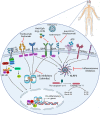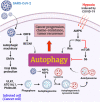Structural and non-structural proteins in SARS-CoV-2: potential aspects to COVID-19 treatment or prevention of progression of related diseases
- PMID: 37189112
- PMCID: PMC10183699
- DOI: 10.1186/s12964-023-01104-5
Structural and non-structural proteins in SARS-CoV-2: potential aspects to COVID-19 treatment or prevention of progression of related diseases
Abstract
Coronavirus disease 2019 (COVID-19) is caused by a new member of the Coronaviridae family known as severe acute respiratory syndrome coronavirus 2 (SARS-CoV-2). There are structural and non-structural proteins (NSPs) in the genome of this virus. S, M, H, and E proteins are structural proteins, and NSPs include accessory and replicase proteins. The structural and NSP components of SARS-CoV-2 play an important role in its infectivity, and some of them may be important in the pathogenesis of chronic diseases, including cancer, coagulation disorders, neurodegenerative disorders, and cardiovascular diseases. The SARS-CoV-2 proteins interact with targets such as angiotensin-converting enzyme 2 (ACE2) receptor. In addition, SARS-CoV-2 can stimulate pathological intracellular signaling pathways by triggering transcription factor hypoxia-inducible factor-1 (HIF-1), neuropilin-1 (NRP-1), CD147, and Eph receptors, which play important roles in the progression of neurodegenerative diseases like Alzheimer's disease, epilepsy, and multiple sclerosis, and multiple cancers such as glioblastoma, lung malignancies, and leukemias. Several compounds such as polyphenols, doxazosin, baricitinib, and ruxolitinib could inhibit these interactions. It has been demonstrated that the SARS-CoV-2 spike protein has a stronger affinity for human ACE2 than the spike protein of SARS-CoV, leading the current study to hypothesize that the newly produced variant Omicron receptor-binding domain (RBD) binds to human ACE2 more strongly than the primary strain. SARS and Middle East respiratory syndrome (MERS) viruses against structural and NSPs have become resistant to previous vaccines. Therefore, the review of recent studies and the performance of current vaccines and their effects on COVID-19 and related diseases has become a vital need to deal with the current conditions. This review examines the potential role of these SARS-CoV-2 proteins in the initiation of chronic diseases, and it is anticipated that these proteins could serve as components of an effective vaccine or treatment for COVID-19 and related diseases. Video Abstract.
Keywords: COVID-19; Non-structural proteins; SARS-CoV-2; Structural proteins; Vaccine.
© 2023. The Author(s).
Conflict of interest statement
The authors declare no competing interests.
Figures







References
-
- Ortiz-Prado E, Simbaña-Rivera K, Gomez-Barreno L, Rubio-Neira M, Guaman LP, Kyriakidis NC, et al. Clinical, molecular, and epidemiological characterization of the SARS-CoV-2 virus and the Coronavirus Disease 2019 (COVID-19), a comprehensive literature review. Diagn Microbiol Infect Dis. 2020;98(1):115094. doi: 10.1016/j.diagmicrobio.2020.115094. - DOI - PMC - PubMed
Publication types
MeSH terms
Substances
LinkOut - more resources
Full Text Sources
Medical
Miscellaneous

